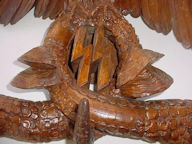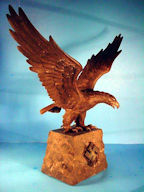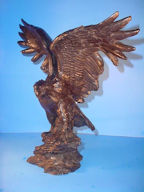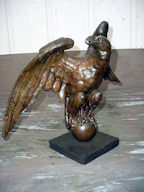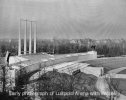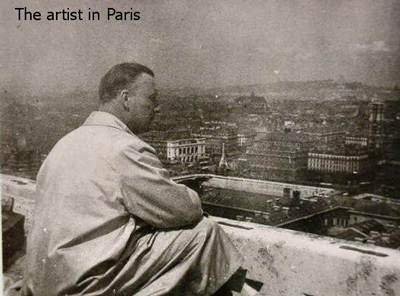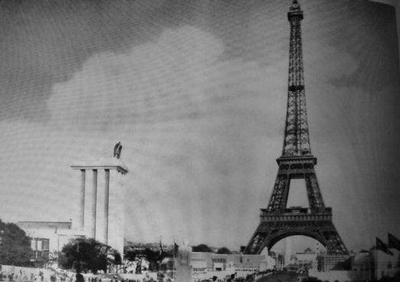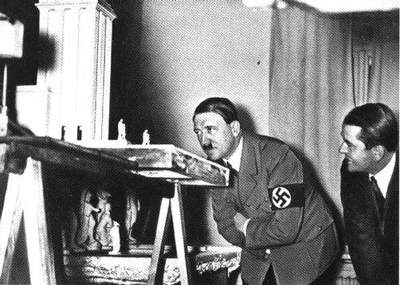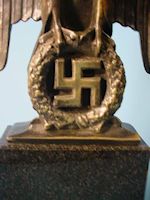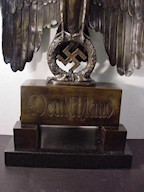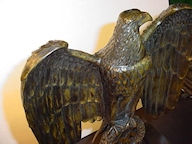|
[ Home Page ]
[ Third Reich ]
[ Old Reich ]
[ Kaiser Reich ]
[ Imperial Russia ]
[ Axis Powers ]
[ Italian Fascist ]
[ WW I ]
[ Landsknecht ]
[ Kaiser Wilhelm ]
[ Frederick the Great ]
Eagles
Page 1
|
|
|
Target Prize for Excellent Shooting (1940) Luftwaffe?
Hunting & Shooting and Luftwaffe (Item EAGLE 1-1; HUNT 7-8; LUFT 14-13)
|
| DESCRIPTION: Here is one of the famed targets that were given as prizes at shooting competitions. This one was won by a Jean Bratengeier. It’s signed by the artist in 1940, when it was presented. This was the Kriegsjahr 1940 (War Year 1940). It says: “Abschiessen,” meaning “shooting down,” “downwind?” “downward?” Inside the black bezel it says: “Wir kommen Schon.” This seems to translate to: “We’re already coming.” We believe all of this refers to the Battle of Britain, August 1940 to May 1941. The obvious look of these white-tailed eagles flying westward over water and toward the banks or cliffs (Dover?) we think says it all! The determined looks on the faces of the birds also serve to make this assumption feasible. The “shooting down” statement would suggest that Jean may have been a bombardier or belly gunner on a German bomber aircraft. In any case this is an important WWII art object and historic relic that would look great in any good collection of the Luftwaffe or general Wehrmacht items.
PRICE: SOLD
|

|

|

|

|

|

SS volunteer in Norway
|

Norwegian Waffen-SS in 1942
|

Soldier of the Waffen-SS Division Nordland
|

Banner of the Norske Legion
|

Norwegian SS recruiting poster
|

Sea eagle preparing to swoop in for the kill
|
Carved Sea Eagle from an  Unit in Norway (Item EAGLE 1-2; WAF 14-11; SS 38-12) Unit in Norway (Item EAGLE 1-2; WAF 14-11; SS 38-12) |
DESCRIPTION: The noble sea eagle has been a revered symbol of the Viking Norse warriors in Norway and Sweden for centuries. This (der Seeadler) was emblazoned on their shields and often on the frontal sail of their long ships. The bird had sacred connotations to these brave raiders. Likewise, the 15,000 men of the Norwegian  volunteer forces and Wehrmacht recruits highly honored this magnificent predator. It is strange, however, that not one of the uniform insignia reveals depictions of this bird because in National Socialist Germany the eagle is predominant on practically everything. It is noted here that at a certain antique store in Germany an old woman had brought a large package that was being carried by her grandson. It contained a curious wooden sculpture. One year earlier she had promised our picker that she would bring “next year” a very precious item owned by her late husband who was a volunteer in the Waffen-SS Division “Viking” and early on had been a member of a Norwegian fascist party, Nasjonal Samling (N.S. for National Unity). Unknown to us but revealed later was the fact that among the recent recruits at that time there was a small but elite unit known as the Headquarters #4 of the Norske Legion, known also as Frontkjempermerke. So great was the spirit within them concerning the fight for Norway and Europe that they celebrated by establishing a communal barracks that was beautifully furnished with such things as carved Viking-era chairs, dragon ships on maneuver, and this wonderful carved Seealder with runic SS insignia. When these men went to war first as the Norske Legion the lady’s husband who had assisted in the carving made sure to take a wonderful carving of the Norse God Wotan, a magnificent huge Viking chair, and the carved sea eagle back to his home and it stayed there in their possession for the last 70-plus years. The lady wanted to keep all the other items, but consented to let the Seeadler go and that is how we came to own it today. The carving is nothing short of phenomenal; possibly the best wood sculpturing we have ever seen. Norwegian woodcarvers are world renowned to be the equal to the craftsmen of Germany’s Black Forest. volunteer forces and Wehrmacht recruits highly honored this magnificent predator. It is strange, however, that not one of the uniform insignia reveals depictions of this bird because in National Socialist Germany the eagle is predominant on practically everything. It is noted here that at a certain antique store in Germany an old woman had brought a large package that was being carried by her grandson. It contained a curious wooden sculpture. One year earlier she had promised our picker that she would bring “next year” a very precious item owned by her late husband who was a volunteer in the Waffen-SS Division “Viking” and early on had been a member of a Norwegian fascist party, Nasjonal Samling (N.S. for National Unity). Unknown to us but revealed later was the fact that among the recent recruits at that time there was a small but elite unit known as the Headquarters #4 of the Norske Legion, known also as Frontkjempermerke. So great was the spirit within them concerning the fight for Norway and Europe that they celebrated by establishing a communal barracks that was beautifully furnished with such things as carved Viking-era chairs, dragon ships on maneuver, and this wonderful carved Seealder with runic SS insignia. When these men went to war first as the Norske Legion the lady’s husband who had assisted in the carving made sure to take a wonderful carving of the Norse God Wotan, a magnificent huge Viking chair, and the carved sea eagle back to his home and it stayed there in their possession for the last 70-plus years. The lady wanted to keep all the other items, but consented to let the Seeadler go and that is how we came to own it today. The carving is nothing short of phenomenal; possibly the best wood sculpturing we have ever seen. Norwegian woodcarvers are world renowned to be the equal to the craftsmen of Germany’s Black Forest.
The Eagle
The feathers of the chest and wings are incredibly real looking. This is a “regal eagle” indeed from beak to claw. We believe he was used as a hanging device for coats of the  officers because of the hooklike branches; six in all that extend from the carving above. There are clam-shaped objects, but probably are barnacles. They are seen butting up against the wreath that contains the officers because of the hooklike branches; six in all that extend from the carving above. There are clam-shaped objects, but probably are barnacles. They are seen butting up against the wreath that contains the  runes. Please look carefully at our images and take in the beautiful detail of the work—every feather is really a separate art piece. The bird is fairly large, measuring from its bottom branch hook to the top of its head at 21 inches and from the right branch to the left it measures 35 inches. The wingtips from side to side measure 21 inches across. There is a metal ring on the back that was used by the original owners to suspend it on a wall. It is obviously unique and certainly historically important to the history of the foreign volunteers of the Waffen-SS.
Footnote: These large raptors are commonly known sea eagles or white-tailed eagles. In Norway, the locals refer to it as the sea eagle; hence, Seeadler (havørn in Norwegian). More than half of their population is in Norway. Except in the extreme north of the country, these birds are year-round residents there. Some are found in sizeable populations in Greenland and Germany. They have the largest wingspan of any eagle and are closely related to the bald eagle. They build their nests on coastal cliffs. Food is usually fish, but sea eagles are opportunistic and will eat mammals and other birds. It is certainly reasonable and even obvious to see that the Norge runes. Please look carefully at our images and take in the beautiful detail of the work—every feather is really a separate art piece. The bird is fairly large, measuring from its bottom branch hook to the top of its head at 21 inches and from the right branch to the left it measures 35 inches. The wingtips from side to side measure 21 inches across. There is a metal ring on the back that was used by the original owners to suspend it on a wall. It is obviously unique and certainly historically important to the history of the foreign volunteers of the Waffen-SS.
Footnote: These large raptors are commonly known sea eagles or white-tailed eagles. In Norway, the locals refer to it as the sea eagle; hence, Seeadler (havørn in Norwegian). More than half of their population is in Norway. Except in the extreme north of the country, these birds are year-round residents there. Some are found in sizeable populations in Greenland and Germany. They have the largest wingspan of any eagle and are closely related to the bald eagle. They build their nests on coastal cliffs. Food is usually fish, but sea eagles are opportunistic and will eat mammals and other birds. It is certainly reasonable and even obvious to see that the Norge  units would admire and gravitate to using this magnificent bird for the mascot of their particular corps. This creature is like the units would admire and gravitate to using this magnificent bird for the mascot of their particular corps. This creature is like the  organization, itself—the elite of the species. organization, itself—the elite of the species.
PRICE: SOLD
|

|

|
Third Reich Bronze Eagle (Item EAGLE 1-3) |
| DESCRIPTION: Here is a magnificent and dramatic-looking bronze eagle mounted on a block of natural quartz. The eagle is depicted getting ready for flight. He represents the awakening of Germany and the advent of National Socialism. He is crafted in natural bronze. His wingspan measures 18 inches. His beak to the end of the tail feathers is about 10 inches. Mounted on the quartz plinth is a swastika that measures about 2 inches all around. The artist was a stickler for detail and every long feather and short feather is highly detailed. The quartz plinth measures about four by four inches at the bottom of the base. As the base goes up it gets slightly narrower and the eagle’s awesome talons are tightly adhered to the base. This is definitely a pre-Machtergreifung (assumption of power) piece that probably graced the desk of a party leader. This eagle is heavy–15 pounds 12 ounces.
PRICE: SOLD
|

|

|
Utterly Magnificent Bronze Eagle from Germany (Item EAGLE 1-4) |
| DESCRIPTION: This eagle is nothing short of great. He is depicted in bronze as he makes ready for flight. His wingtips protrude into the air and are awesome looking. He stands on a perch that is depicted as a mountain rock. The artist unfortunately did not sign the piece, but it is definitely the work of a master sculptor. The manner in which the artist depicted the wings is very unusual in eagle sculptures. The beak of the eagle is open as if screaming out defiance against the enemies of the Fatherland. From every angle this sculpture is extremely realistic and unique. The wingspan of the eagle is 15 inches. If you were to measure the sculpture from a wingtip to the bottom of the base it would be about 17 inches. The statue probably dates back to the German Imperial period, but was taken near Berlin in World War 2. It is a typical desk piece or something that would be found on a fireplace mantel, but it certainly would have been considered a precious possession. The weight of the piece is 12 pounds, 13 ounces. The bottom of the inside of the plinth shows some cemented material; this is probably because the sculpture was once adhered to a further marble base. This does not detract at all from the beauty of this noble artwork: truly rare!
PRICE: $800.00.
|

|

|
Very Large Early American Colonial Eagle in Bronze (Item EAGLE 1-5; USARTICLES 3-25) |
| DESCRIPTION: Here is a truly beautiful bronze sculpture probably produced in the mid nineteenth century. This eagle is of the style and type used in courtrooms and sometimes in legal offices. Eagles like this often graced patriotic meeting places. The eagle sits on a ball that is said to represent the globe and the pursuit of justice throughout the world. Wings tip to tip measure 24 inches, and is 15 inches high. The base is 8 x 8 x 2 inches. This bird is quite heavy, weighing in at about 40 pounds. The figure is mounted on a piece of wood. Originally, it could have been mounted on a marble base or even a metal pole-like implement (long gone). If this makes its way to a good collection then it deserves to have a marble plinth fitted to it (author’s suggestion). This is truly a great and historically important relic of the early times in America.
PRICE: $2,800.00.
|
|
|
|
Black Forest Carved Eagle (Item EAGLE 1-6; WOODMASTER 1-1)
|
|
DESCRIPTION: Here is an absolute masterpiece of the wood carver’s art; a consummate treasure of the art. We have never seen such
excellence in Black Forest art, before. If he were not made of wood you would swear he could fly, since every feather is so realistically
accomplished as to seem to be ready for flight. This bird of prey is large and heavy, measuring 31 inches from wingtip to wingtip, and from the
bottom of the plinth—that looks like a rock—to the top of his head it measure 16 inches. The proud eagle has always been the German icon and
this fellow personifies the image. This one practically transcends the traditional Black Forest art description. It is truly the Stoltz
Deutschen Adler in its finest portrayal.
PRICE: $6,500.00
|
|

|

|
|

|

|

|

|

|

|

Prof. Speer and Adolf Hitler planning the position of the giant eagle by Ehmens
|
|
Bronze Nuremberg Eagle by Kurt Schmid Ehmen (Item EAGLE 1-7; PARTEI 2-10; ART 9-1; BRONZE 1-4)
|
DESCRIPTION: Here is one of the greatest finds for Germania International, LLC for 2005. Our specialty has always been to have our pickers in Germany investigate various companies that produced objects such as jewelry, insignia, and art during the Third Reich era. As a result they have turned up some wonderful finds. In this case we located a company known as Preussische Bergwerks u. Hütten AG. It was located in the outskirts of Berlin in the community of Gleiwitz, a town known for iron and bronze art pieces through hundreds of years. Many fantastic pieces of iron and bronze objects d’art were manufactured there between 1813 and 1815. For instance, more than eight thousand Iron Crosses for the heroes who fought against Napoleon were forged in the Gleiwitz foundries. The design was by Karl F. Schinkel. Adolf Hitler mentions the “iron of Gleiwitzer” in the ‘table-talk book,’ page 656. The Kunstguss company that our German associates and researchers found for us and visited was falsely accused of using slave labor in 1945 at the “STAR Chamber Proceedings” in 1945. Many Third Reich items of art were produced by Kunstgiessereigleiwitz and especially by Hütten AG. One of the most often seen in fine collections and museums is the very famous Nuremberg Eagle as designed and sculpted by the famous Third Reich sculptor Kurt Schmid Ehmen, October 13, 1901-July 14, 1968.
He was a world-renowned artist in bronze and stone. The listing of his works in the Third Reich period are legion to include the famous eagle to commemorate the martyrs of the November 9th Putsch at the Feldherrenhalle in Munich, the national eagles on the Führerbau in the Königsplatz, and even the eagles in stone for the four corners of the congress building of the German museum in Munich (they can still be seen today). The wonderful eagle that was to be seen on Der Haus der Deutschen Kunst in Munich and the golden eagle that topped the German pavilion at the Paris World’s Fair were executed by Ehmen. Today all that remains of his monumental work are the four eagles on the museum in Munich. Now we have unearthed what can be considered a tribute to this prolific and dedicated artist and this utterly fantastic discovery takes the form of several solid-bronze editions of the most famous of the Ehmen masterpieces, “The Tribune Eagles” from the Nuremberg Parteitag grounds. These wonderful sculptures are desk eagles that were bought at a fairly high price in their day to be given as gifts to the faithful to the N.S. ideals. The bronze editions cost much more than the more common examples in Weissmetal (white metal or zinc). These pieces were an expensive souvenir, but they were souvenirs not made for any official party function. The detail is great considering the casting process. Yes, they were made in Gleiwitz by the thousands, but today are extremely rare considering the de-Nazification process put in place by the ‘winners’ and the leftist postwar government of Germany. The company officials who sold these pieces just couldn’t bear to see these little gems of history destroyed and that without further adieu is the precise reason that you would have had the chance to acquire one of these Schmid Ehmen eagles to grace your collection. The span of the wings is 6 inches. The height of the sculpture is 7 inches with another 1 1/4 inches for the base. The bases are done with the utmost care and are exactly the same stock provided and used in the 1930s and 1940s. Some of the eagles had to have the patina refurbished to have once again the glorious finished patina. This Deutsch-Adler is without a doubt one of the most impressive art pieces in Third Reich sculpture. This more than any other artistic creation personified the Geist (spirit) of the National Socialist Bewegung (movement and ideals). In our supporting documentation we present for your historical information some images of previously unpublished photographs of the designing and construction of the original monumental Nuremberg Eagles and images of other Ehmen works. The pictures are from an original album having belonged to Herr Ehmen. In this album he showed photographs of various projects such as the planning and construction of the Mahnmal at the Feldherrenhalle, the magnificent eagles over the entrances of the Führerbau and Parteibau at the Königsplatz in Munich and there were many photos of his most grand project, the Tribune Eagles of the Luitpold Arena at the Nuremburg Party Rally grounds. Those eagles were destroyed in an act of cultural vandalism. Now, although smaller, the Ehmen eagles once more emerged not in the cheaper version in Weissmetal, but in glorious bronze just like the originals at the glorious Reichsparteitags der NSDAP. All the original eagles that we had were previously sold and now we were lucky enough as of May 2015, to have exact copies made to exact proportion and exact detail.
PRICE: SOLD
|
 Back view
Back view |
 Helmet is for viewer
Helmet is for viewer
perspective only |
 Interesting combination presented
Interesting combination presented
for artistic appreciation |
 |
|
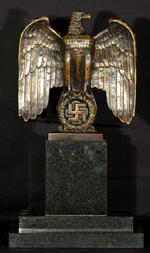 |
Kurt Schmid Ehmens Bronze Sculpture of the Magnificent Eagle of the German Pavilion at the 1937 World’s Fair in Paris
(Item EAGLE 1-8; PARTEI 2-11 & ART 9-1A; BRONZE 1-5) |
DESCRIPTION: Earlier on these pages, in the description of the Nuremberg Tribune Eagles by the artist Kurt Schmid Ehmen you will have read about our fortunate discovery and purchase of several of those wonderful eagle sculptures that were cast in the late 30’s and early 40’s at the Preussische Bergwerks u. Hutten A.G. in their Gleiwitz Foundries near Berlin. The artist, of course, of this eagle was none other than Herr Kurt Schmidt Ehmen (1901-1968). You can read about him and the Bergwerks foundry in the narrative at PARTEI 2-10 (above). Ehmen was the “Adlermeister” of the Third Reich and you can see mention of many of the most famous sites throughout the Reich where his sculpted masterpieces were displayed. We have cited several places that the National Socialists considered sacred or sacrosanct and the works of this artist were effectively employed, the list is most impressive. This Adlermeister or ‘Eagle Master’ was considered one of the finest bronze sculptors of Germany and right up there in the ranks of Arno Brecker and Josef Thorak.
After the Party Congress eagles were unveiled and presented to the German public there was a huge demand for artistic renditions of them. The Nuremberg eagles were produced in zinc castings, bronze sculpture, and even sometimes in wood by the Black Forest carvers in the Alps. They were sold as souvenirs throughout the Reich especially at the stores in Nuremberg and surrounding areas at the time of the rallies and the ones that were in bronze by the Bergwerk u. Hutten were considered the best! They were definitely high-end souvenirs and were not made for any particular Party group or function. They were really quite costly in their day. Compared however to the white metal figures made mostly in Bavaria, they cost much more but were really superior in design and general good looks. Very dramatic in design. There was one sculpture however by Schmidt Ehmen that artistically exceeded the Tribune Eagles and that was the lofty, resplendent eagle that was created to be on the top of the Great Exhibition Hall in the German pavilion of the 1937 Paris World’s Fair. This was the absolutely majestic edifice designed by Albert Speer, Hitler’s great ‘Architect Extraordinaire’ and it was Kurt Schmid Ehmen who Speer commissioned to design and build the giant eagle that was seen dominating the view over all of the exhibition grounds. The power and majesty of this tower and this eagle figure were extremely awesome. At one point in time we had in our possession a scrapbook that belonged to the family who were the owners and proprietors of the Prussian Bergwerk u. Hutten AG. The family had collected photographs of the construction of the famous Paris eagle and also some great ones of the artist himself and his crew at work. There was also a great photo of the German Führer Adolf Hitler as he views two Schmidt Ehmen eagles along with architect Speer, prior to the finished masterpieces being erected.
Now in a much more limited number thanks to our picker we received four of the Paris Exhibition bronze models that were produced at Gleiwitz at the same time as the Nuremberg eagles. The Paris eagle is much larger, bolder and a bit more detailed and although at first glance it looks very similar it is decidedly different and of course mounted much differently. With the gorgeous three tier marble base, the sculpture measures almost 20 inches high. The bronze eagle by itself is 10 inches high and 10 inches across the wing span. The base is in three separate marble tiers, The largest standing vertically that directly supports the eagle stands at 6"x 5" and 2 inches thick. The next horizontal piece of marble that the above marble piece is standing on is 9 x 3 inches and the bottom plinth is 11 inches long and 1 inch thick. The piece weighs a “heavy” 33 pounds. It is our opinion that this eagle has to just about be one of the finest and greatest relics of the Third Reich. There are items that are even rarer and certainly more expensive but when I think of the typical aesthetic style of the Thousand Year Reich, the first things that come to mind that reflect all the glory and power present at that time, would be the 1936 officers dagger with chain hanger and the Kurt Schmid Ehmen eagle. Nothing to me is in the end, more purely National Socialist.
The Bergwerks foundry did not produce marble. That material had to be obtained back then at a nearby quarry firm near Gleiwitz. So everything was as it should have been and as it was in the Third Reich. The color, the size, the construction of the base is done to perfection and the marble or granite is in fine jet-black perfect stone. So in essence, the entire first sculptures were 100% original. The eagles are unsigned. The only one that we encountered signed was the pilot piece, and we think it was the single exception.
We want to make it clear that no company still in existence today officially sold us these first eagles...they were bought from the relative of a onetime company official who was able to preserve them in secrecy all these years and now thought they should be out there in the collector and museum world. This eagle would make the ultimate center piece of any fine collection. Here is a noble bird that commands respect and dignity and could be the most overpowering item in your house other than possibly “the little lady”!
PRICE: SOLD
|
|
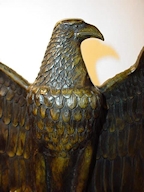
|

|

|

Back of plinth
|

Helmet placed for perspective
|
|
|
Deutschland Eagle (Item EAGLE 1-9; PARTEI 2-12; BRONZE 1-5a)
|
| DESCRIPTION: Here is the ultimate Schmid Ehmen eagle in bronze. Here was the greatest eagle sculpted by this man referred to as the “Adlermeister.” If you read the information proffered in the two articles above: Item Bronze 1-4 and Bronze 1-5 you will see how we managed to come by this one and the others from the group discovered in Germany in the year 2005. The items like the others were cast in the 30s at the Prussian Bergwerks U. Hutten AG. This foundry was located in the outskirts of Berlin in the community of Glewitz. Its main sales office was in Berlin. This company was responsible for the production of many beautiful bronze sculptures by many famous artists sculpting in the era of the Third Reich, but none so prolific as Kurt Schmid Ehemen, who rated up there with Arno Brecker and Josef Thorak. It was this artist who produced the Tribune Eagles in giant proportion seen on the ramparts of the Nuremberg Stadium. Those eagles were similar to the one we present at Bronze 1-4 on this page. Every eagle had a similarity, but each had its own distinctive features as well. The Paris Eagle at Bronze 1-5 that topped the tower at the 1937 World’s Fair was a bit different than the Nuremberg eagle and different again from this Deutschland eagle. Also, the marble base is much more elaborate and we feel that this one undoubtedly cost far more in its day than the others and may have actually been a state award for a party official or important personage who might have given funds for the promotion or needed support for the Nuremberg Party Rally of 1938. This rally was named the Reichsparteitag Großdeutschland (Rally of Greater Germany). This was the last Parteitag at Nuremberg. The rally of 1939 that was to be the Parteitag of Peace had to be called off because of the machinations of France and England and the sudden murders of many of the German minority in Poland. Germany was forced into war and the “Rally of Peace” never materialized. We feel strongly that the word “Deutschland” on the plinth of this sculpture was definitely connected to the 1938 rally and was ultimately more important than a souvenir piece like the small Kurt Ehemen eagle as seen in Bronze 1-4. However, that eagle, although smaller, is also an important art piece. This eagle, with its marble plinth, measures 18 inches high and the eagle by itself is 2 inches larger than the Paris eagle. The wingspan is 11 inches and is also larger than the Paris eagle. The swastika in the wreath gripped by the eagle’s talons is cut out in such way as to be able to view the eagle’s tail feathers, also unlike the swastikas on the other pieces seen above. The swastika is mobile rather than squared off. The marble or granite plinth is very unusual and is trophy oriented in its presentation. That more than anything else tells us that it is not a mere purchased souvenir, but rather a coveted prize or possibly a state trophy? All in all, with its grandiose look and meaningful emblazoned word it is probably the finest N.S. patriotic piece we could ever imagine as the personification of that glorious era of German history.
PRICE: SOLD
|
|

|

|

|

|

|

Helmet is for size perspective.
|
|

Bronze eagle is for size perspective
|

|

|

|

|

|
|

|

|

Third Reich Book
|

|

|

Postcard of the Reich
|
|
|

Hitler and Leni Reiefenstahl
looking up at eagles
|
|
|
|
Huge Hand Carved Nuremberg Stadium Eagle (Item EAGLE 1-10; PARTEI 4-4)
|
| DESCRIPTION: Here is a stupendous carving that replicates the Gigantic Stadium Eagles from the Reich Parteitag (party congress) held at the ancient city of Nuremberg. Two of these massive eagles graced the pillars or plinths in the Luitpoldhain section of the party buildings that form the Reich Parteigalände or party compounds of the NSDAP (Nazi Party). These beautiful and ultra dramatic rallies were held in the years 1923 to 1938 in the Luitpoldhain field. And the Zeppelin field.The famed sculptor Kurt Schmid Ehmen designed, sculpted and cast two massive eagles or “Deutsche Adler”. We are not sure if this is the original eagle carving that he might have used as a model for the gigantic pieces but in speculative theory we might even say that it could be an Entwurf or original draft for the stadium eagles coming from the studio of Prof. Ehmen. The eagle was found in a shop in Nuremberg in 2004. Then again it might have been carved by some masterful wood carver for some special exhibition of Volkskunst “Art of the Folk”. Could this have been executed for the purpose of special display sitting above a door to an SA or SS headquarters or Kasserne? We may never know but we do know that the Schmidt Ehmen Eagles made quite a stir among the German people when first unveiled in a” Special Somber Ceremony” almost immediately various pictures, bronze statues, plaster of paris and wooden depictions of them were produced and sold. If you go to PARTEL 2-10 you can see original bronze castings that we unearthed in Germany. These were the much beloved souvenir of the rallies (expensive in their time). The man who we purchased this big one from had two of a smaller size in wood ¼ as big. We bought and sold one of these a few months back. These eagles were revered symbols of a strong and vibrant people whose agenda was the return of the mighty Reich of “Karl Der Grosse” a Reich that brought forward once more the glory and majesty of ancient Rome but ruled and governed by the “Herrenvolk”.The ideological heirs of the Germanic“Imperium”. If anything represented all of this to the German people it was envisioned and personified in the visage of this pair of great stadium eagles. This piece is magnificently carved with all the magnificent detail of the Ehmen originals. It is truly huge. The wood employed seems to be European oak. We cannot imagine any relic of the Reich being so prodigiously impressive and beautiful. Of all the various art pieces of the Third Reich nothing, absolutely nothing would be more Germanic than this wooden masterpiece of Volkskunst.
Sizes noted: From bottom of the plinth to the top of the eagles head measures 47 ½ inches (almost 4 foot high). The base is 21 x 13 x 6 inches deep. The wings each are 27 inches wide and 34 inches long from top to bottom the swastika is 5 inches all around. The wreath diameter is 16 inches. You can see we have offered various some size perspectives in some of the pictures. We set a standard helmet beside the eagle in one picture and one of our bronze eagles in another picture or two. This is a great Third Reich relic; possibly the greatest! It is extremely heavy and as you can see HUGE. It will take special crating and truck shipping or by sea container if it goes back to Europe. The price is quite reasonable when one considers that you would be buying a fantastically important and significant relic of the Reich; gone but not forgotten! $15,500.00 This is possibly the greatest bargain we have ever offered.
PRICE: SOLD
|
|
|
|
Marvelous Reich Eagle Presentation to a Director of Agriculture (Item EAGLE 1-11; ART 18-23; AGRI 1-8)
|
DESCRIPTION: This very impressive bronze eagle is so indicative of the national spirit they had even in agriculture. It was given to a director named Koster, presented in December of 1939 and reads as follows:
“Dedicated to our learned, beloved agricultural Rat. Director Koster, in honor and thankfulness for his sacrifice and excellent performance.
Zwickau, Sachsen Agricultural Club.”
It stands 16 inches tall by 10 inches on a marble base. The detail is very distinct and well executed. It weighs 19 pounds.
PRICE: SOLD
|

|

|
Decorative Third Reich Eagle (Item EAGLE 1-12; ART 18-25)
|
| Well, as you know, we love eagles, but this one is from an unknown source. It is a typical stylized Third Reich eagle and probably attached to something as the attachments are on the back. It’s of heavy steel so was no doubt on something outdoors and made to endure the elements. It measures 11 x 8 inches and is a very impressive piece!
PRICE: SOLD
|
|
|
|
Regal Reich Eagle (Item EAGLE 1-13; ART 18-26; NSD 22-25)
|
| DESCRIPTION: This eagle has a personality all its own. It‘s from the period on a marble base. The bottom has been replaced with green felt. The eagle seems to be of a base metal/zinc extraction. There are no hallmarks on the eagle, but its great detail signifies it did come from an established foundry. The eagle is 7 inches by 6 inches, while the base is 8 inches long by 1 inch high and weighs seven pounds. The obverse is just as detailed and one can see the swastika beneath the tail feathers. Expense was no object in its production for the eagle sits on Marquina (black marble) with its characteristic veins of crystalized minerals. This marble is rarer than Italian marble. This is the perfect addition to any collection where it will be a focal point of any room.
PRICE: SOLD
|
|
|
|
Decorative Reich Stylized Eagle (Item EAGLE 1-14)
|
| DESCRIPTION: Well, as you know, we love eagles, but this one is from an unknown source. It’s a typical stylized Third Reich eagle and probably attached to something as the attachments are on the back. It’s of heavy bronze so was no doubt on something outdoors and made to endure the elements. It measures 11 x 8 inches and is a very impressive piece!
PRICE: SOLD
|
|
|
Third Reich Eagle Topper (Item EAGLE 1-15)
|
| DESCRIPTION: Here is another regal eagle that apparently had sat atop something. It is of base metal, painted black with terrific detail as one would expect. It is 8 inches high by 7 inches.
PRICE: $375.00
|
|
|
Carved Wooden National Third Reich Eagle (Item EAGLE 1-16; NSD 22-37; ART 18-29)
|
| DESCRIPTION: Well, as you know, we love eagles! This one is of a genre that is getting next to impossible to obtain unless they are re-created and this one is not. It shows all the natural wear and aging in the wood that we would expect of a period-carved eagle. It measures 19 inches wide x 17½ inches high, and is in excellent condition. The detail is most intricate in both the body and wings. This is a beautiful display piece!
PRICE: $5,000.00
|
| |
 volunteer forces and Wehrmacht recruits highly honored this magnificent predator. It is strange, however, that not one of the uniform insignia reveals depictions of this bird because in National Socialist Germany the eagle is predominant on practically everything. It is noted here that at a certain antique store in Germany an old woman had brought a large package that was being carried by her grandson. It contained a curious wooden sculpture. One year earlier she had promised our picker that she would bring “next year” a very precious item owned by her late husband who was a volunteer in the Waffen-SS Division “Viking” and early on had been a member of a Norwegian fascist party, Nasjonal Samling (N.S. for National Unity). Unknown to us but revealed later was the fact that among the recent recruits at that time there was a small but elite unit known as the Headquarters #4 of the Norske Legion, known also as Frontkjempermerke. So great was the spirit within them concerning the fight for Norway and Europe that they celebrated by establishing a communal barracks that was beautifully furnished with such things as carved Viking-era chairs, dragon ships on maneuver, and this wonderful carved Seealder with runic SS insignia. When these men went to war first as the Norske Legion the lady’s husband who had assisted in the carving made sure to take a wonderful carving of the Norse God Wotan, a magnificent huge Viking chair, and the carved sea eagle back to his home and it stayed there in their possession for the last 70-plus years. The lady wanted to keep all the other items, but consented to let the Seeadler go and that is how we came to own it today. The carving is nothing short of phenomenal; possibly the best wood sculpturing we have ever seen. Norwegian woodcarvers are world renowned to be the equal to the craftsmen of Germany’s Black Forest.
volunteer forces and Wehrmacht recruits highly honored this magnificent predator. It is strange, however, that not one of the uniform insignia reveals depictions of this bird because in National Socialist Germany the eagle is predominant on practically everything. It is noted here that at a certain antique store in Germany an old woman had brought a large package that was being carried by her grandson. It contained a curious wooden sculpture. One year earlier she had promised our picker that she would bring “next year” a very precious item owned by her late husband who was a volunteer in the Waffen-SS Division “Viking” and early on had been a member of a Norwegian fascist party, Nasjonal Samling (N.S. for National Unity). Unknown to us but revealed later was the fact that among the recent recruits at that time there was a small but elite unit known as the Headquarters #4 of the Norske Legion, known also as Frontkjempermerke. So great was the spirit within them concerning the fight for Norway and Europe that they celebrated by establishing a communal barracks that was beautifully furnished with such things as carved Viking-era chairs, dragon ships on maneuver, and this wonderful carved Seealder with runic SS insignia. When these men went to war first as the Norske Legion the lady’s husband who had assisted in the carving made sure to take a wonderful carving of the Norse God Wotan, a magnificent huge Viking chair, and the carved sea eagle back to his home and it stayed there in their possession for the last 70-plus years. The lady wanted to keep all the other items, but consented to let the Seeadler go and that is how we came to own it today. The carving is nothing short of phenomenal; possibly the best wood sculpturing we have ever seen. Norwegian woodcarvers are world renowned to be the equal to the craftsmen of Germany’s Black Forest. officers because of the hooklike branches; six in all that extend from the carving above. There are clam-shaped objects, but probably are barnacles. They are seen butting up against the wreath that contains the
officers because of the hooklike branches; six in all that extend from the carving above. There are clam-shaped objects, but probably are barnacles. They are seen butting up against the wreath that contains the  runes. Please look carefully at our images and take in the beautiful detail of the work—every feather is really a separate art piece. The bird is fairly large, measuring from its bottom branch hook to the top of its head at 21 inches and from the right branch to the left it measures 35 inches. The wingtips from side to side measure 21 inches across. There is a metal ring on the back that was used by the original owners to suspend it on a wall. It is obviously unique and certainly historically important to the history of the foreign volunteers of the Waffen-SS.
Footnote: These large raptors are commonly known sea eagles or white-tailed eagles. In Norway, the locals refer to it as the sea eagle; hence, Seeadler (havørn in Norwegian). More than half of their population is in Norway. Except in the extreme north of the country, these birds are year-round residents there. Some are found in sizeable populations in Greenland and Germany. They have the largest wingspan of any eagle and are closely related to the bald eagle. They build their nests on coastal cliffs. Food is usually fish, but sea eagles are opportunistic and will eat mammals and other birds. It is certainly reasonable and even obvious to see that the Norge
runes. Please look carefully at our images and take in the beautiful detail of the work—every feather is really a separate art piece. The bird is fairly large, measuring from its bottom branch hook to the top of its head at 21 inches and from the right branch to the left it measures 35 inches. The wingtips from side to side measure 21 inches across. There is a metal ring on the back that was used by the original owners to suspend it on a wall. It is obviously unique and certainly historically important to the history of the foreign volunteers of the Waffen-SS.
Footnote: These large raptors are commonly known sea eagles or white-tailed eagles. In Norway, the locals refer to it as the sea eagle; hence, Seeadler (havørn in Norwegian). More than half of their population is in Norway. Except in the extreme north of the country, these birds are year-round residents there. Some are found in sizeable populations in Greenland and Germany. They have the largest wingspan of any eagle and are closely related to the bald eagle. They build their nests on coastal cliffs. Food is usually fish, but sea eagles are opportunistic and will eat mammals and other birds. It is certainly reasonable and even obvious to see that the Norge  units would admire and gravitate to using this magnificent bird for the mascot of their particular corps. This creature is like the
units would admire and gravitate to using this magnificent bird for the mascot of their particular corps. This creature is like the  organization, itself—the elite of the species.
organization, itself—the elite of the species.



















